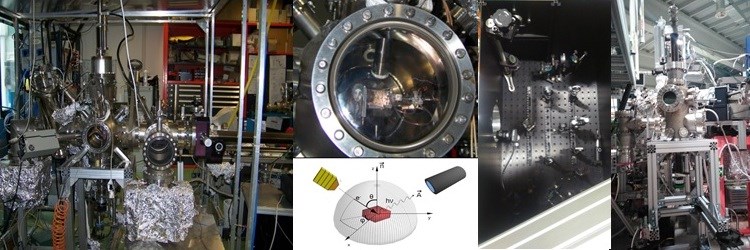

SIPE laboratory is focused on the electronic structure and dynamics study of low-dimensional materials and includes 2 IPES chambers (one at IOM-PG) and one TRXAS end-station.
The SIPE set of Vacuum apparatuses are dedicated to the study of Materials, surfaces and interfaces by means of electron and X-ray Spectroscopy techniques. The Laboratory comprises one operative and 2 endstations in commissioning.
The main KRIPES endstation equipped with an electron analyzer and a MBE stage for the in-situ preparation of samples, The main KRIPES chamber is equipped with a six-axes manipulator and a custom highly collimated beam electron gun and a set of photon detectors. The e-gun can be moved with respect to the sample, making the setup extremely versatile in terms of the possible measurement configurations. The chamber is controlled by a user-friendly acquisition program.
TR-XAS. The main goal of this end-station is the angular flexibility, the impinging laser visible light (pump) and the X-ray (probe) and of the detectors. The design and building of the UHV system have been made thanks to the collaboration with IOM technical services. The apparatus is now in commissioning within a long-term proposal approved recently, in collaboration with BACH beamline equipped with an integrated femtosecond laser setup.
IPES-SMALL. A small apparatus for the new Inverse Photoemission instrumentation development is operative and a new detector for VIS photons is in commissioning.
Software:
The acquisition programs of the three apparatuses has being developed in house in LabVIEW.
We developed a code meant to simulate TRXAS experiments on solid samples in order maximize the excitation yield (pump ratio) and the signal to noise ratio S/N in VIS pump and X-ray probe experiments in Synchrotron and Free Electron Laser. The user-friendly version of the simulation of TRXAS code has being developed in Phyton. The code has been used to test different TRXAS chamber configurations.
Instrumentation:
All 3 chambers will be equipped with sample holders compatible with APE and BACH standards.
The main KRIPES chamber have been commissioned for user-friendly experiments within the open access activity.
The TRXAS end station includes a new conception of laser geometry with a variable impinging angle, developed in with Federico Cilento (Elettra Sincrotrone Trieste). The system consists of a 4-axis manipulator with a variable temperature 100-1000K sample holder, a telemicroscope, and 2 detectors that are independently routable around the chamber axis (photodiode and micro channel-plate).
A UHV chamber IPES-SMALL is operative and dedicated to the development of new detector and electron gun based on new cathode models.
Multitechnique characterization of low dimensional systems complementary with other IOM lines, focused on the interrelation between structure by XRD and electronic properties by XAS, including dynamics, and by IPES thanks to the sensitivity of the unoccupied electronic structure to structural details. Topics: 1 Growth and characterization of Organic thin films (radicals, tetrapyrroles porphyrines, phthalocyanines) of technological interest for organic electronics, energy harvesting and spintronic. The aim is to define growth protocols optimization, to engineering the energy level alignment, promoting charge transport and photovoltaic efficiency. 2 Interfaces between the organic layers and metals, Graphite and 2D materials. We focused recently on the synthesis of porphyrin-functionalized graphene forming hybrids (Graphyrin) considered promising candidates in the molecular device engineering (electronics, sensors, energy).
De-excitation dynamics and non-equilibrium phenomena in solids focused on a) de-excitation dynamics and related non-equilibrium phenomena induced by photons (laser pump) and electrons (surface photovoltage, surface electron voltage, charge carrier dynamics) for optimization of photoelectronic devices; b) Time resolved studies focused on Fluorescence TRXAS its Multiple Scattering simulation and instrumental developments; c) Building of new photon detectors in the VIS and VUV energy range. The project is in collaboration with ISM. De-Excitation dynamic is also performed by Time Resolved Photoemission in collaboration with CITIUS University of Nova Gorica. Pump-probe measurements in VIS are performed in collaboration with Prof. M. Chergui, EPF of Lausanne, and Prof. E. Stratakis FORTH lab Heraklion Greece.